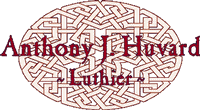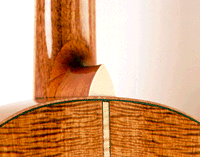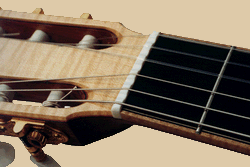
IVORY

| I have used African ivory as fittings on the bridge and heel cap as well as the scalloped nut. Ivory, has for hundreds of years, been considered the perfect material for these applications, but recently I have been in a quandary about whether or not I should continue to use ivory at all. In fact, there are several members of the instrument making community that have reservations about the continued use of this magnificent material. Mr. Laurence Lubin of the Metropolitan Museum of Art has written on the subject as well. |
|
Over the years, as greed began to rear its ugly head, several of the materials traditionally used by the instrument maker to fabricate concert quality instruments have become quite scarce. Some, like ivory and tortoise shell, are now embargoed and found on endangered species lists. The ivory that you see here has been in my possession for more than 20 years it was acquired from legal sources in southern Africa where the game rangers were forced at one time to cull the elephant herds.
Times have changed, and with the advent of the AK47 and AR-15 assault rifle, herds of elephants, and of rhinos have been slaughtered for the sole purpose of poachers harvesting their ivory tusks and horns to sell on the black market. There are several alternatives to ivory, one is micarta, a synthetic; it is very similar in density to ivory. Another synthetic ivory is a polymer marketed by Graph Tech under the brand name Tusq®, it is a superb alternative and is being used extensively by top manufacturers and builders worldwide. For more information, visit their website http://www.islandnet.com/~strattn/graphtech/home.html. | |
| A third, more interesting alternative, is the fruit of the Tagua palm (Phytelephas macrocarpa). The Ivory Nut, as it is called, can be sliced and stained just like real ivory. It's nearly as dense, it's just a serviceable, and it's a renewable resource. Before you leave, take the time to learn something more about our planet's endangered species -- visit EE-Link. | 
|

|
|
copyright 1997, anthony huvard, http://www.cybozone.com site maintained by cyboboy@cybozone.com